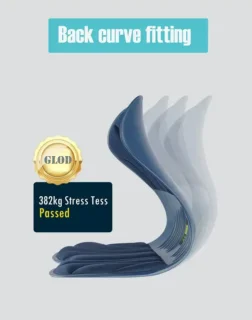What causes lower back pain? and Effective preventive and treatment measures
We often associate certain parts of our body as closely interconnected, such as the wrist and hand. Similarly, individuals who have experienced discomfort in both their lower back and upper buttocks can attest to the strong connection between these regions.
The lower back also referred to as the lumbar region, is situated directly above the buttocks. Lower back pain is a common ailment, affecting millions at any given time. Nerves extending from the lower back into the upper buttocks can give rise to concurrent pain in these areas. Physical therapists are well-equipped to identify the underlying causes of your discomfort and provide effective treatment for lumbar and buttock pain.
Lower back pain, a frequent cause of missed workdays, is widely prevalent. However, pain situated above the buttocks, though less common, also warrants attention and effective management.
So What are the common causes of lower back pain just above the buttocks?
The lumbar region and buttocks comprise intricate anatomical structures, and their close proximity makes it common for pain in one area to affect the other. Physical therapists possess extensive expertise in musculoskeletal disorders that may result in pain in these regions and find the causes. These causes include:
Muscle Strain:
also known as a pulled muscle, is a common injury that occurs when the muscle fibers or tendons are stretched beyond their usual capacity or torn due to excessive force or overuse. It can happen to anyone, from athletes to those who engage in regular physical activities to people who perform sudden, strenuous movements. Here's a detailed cause of muscle strain:
- Overexertion: Engaging in physical activities that your muscles are not conditioned for can lead to strain. This includes lifting heavy objects, running, or sudden bursts of intense exercise.
- Poor Warm-Up: Failing to warm up adequately before exercise can increase the risk of muscle strain.
- Muscle Imbalances: Muscle imbalances, where some muscles are stronger than others, can put excessive stress on certain muscles.
- Fatigue: Muscles are more susceptible to strain when fatigued or tired.
- Age: As people age, their muscles may lose elasticity and become more prone to strain.
- Dehydration: Inadequate hydration can cause muscle cramps and increase the risk of strains.
Herniated Disc:
When the soft tissue inside the spinal disc pushes out, it can compress nerves.
A herniated disk is a condition that affects approximately 2% of the population each year. In most cases, patients experience relief from their symptoms within 12 weeks without requiring specific treatment. This condition occurs when the soft, gel-like center of an intervertebral disk protrudes through a tear in the surrounding outer ring of cartilage. These disks act as cushions for the nearby vertebrae, and when one herniates, it can lead to back pain. The pain associated with a herniated disk often travels down the back of the leg, a condition known as sciatica. The primary symptom of a herniated lumbar disk is typically lower back pain that worsens with prolonged sitting or standing. Additional symptoms may include:
- Numbness or tingling in the legs or feet
- Pain radiating down one or both legs
- Increased pain at night or during physical activity
- Relief from pain while at rest or when bending forward
Treatment for herniated disks typically begins with conservative measures, such as rest, ice or heat therapy, exercise, medication, or physical therapy. Surgery is not the initial treatment option and is only considered if:
- Daily activities become challenging
- Severe pain persists
- There is numbness or weakness
- There is a loss of bladder or bowel control.
The most common surgical procedure for herniated disks is a discectomy, where the surgeon either partially or entirely removes the affected disk. This procedure is performed under general anesthesia through an incision in the back. Microdiscectomy, a minimally invasive approach, is often attempted to reduce recovery time.In some cases, a laminectomy or laminotomy may be recommended, similar to the approach used for lumbar spinal stenosis.
In more complex situations, a spinal fusion may be necessary. During this procedure, the surgeon fuses two or more vertebrae together, providing permanent stability and reducing pressure on nearby nerves. Various sources of bone may be used, including bone from the patient's hip, donor bone, or artificial bone, secured with screws or connecting rods.
Sciatica:
Compression or irritation of the sciatic nerve can cause pain that radiates into the buttocks and down the leg.
Sciatica is a common condition, affecting up to 40% of the population during their lifetimes. It is characterized by pain that specifically targets the sciatic nerve, which is one of the longest nerves in the body, running from the lower back down to the feet. This pain can result from compression, irritation, or pinching of the sciatic nerve at various points along its path.
Typical symptoms of sciatica include:
- Pain radiating from the lower back down to the foot or toes
- Numbness or tingling sensations in the leg or foot
- Sleep disturbances
- Tightness in the buttocks or hip area
It's important to note that sciatica itself is not a standalone condition but rather a symptom of an underlying issue.If you're seeking relief from sciatica and lower back pain, you're not alone; many individuals grapple with these distressing symptoms. Fortunately, there are effective strategies for managing sciatica, including:
- Engaging in core-strengthening exercises
- Maintaining an active lifestyle
- Applying hot and cold packs
- Incorporating gentle stretching routines
It's crucial to strike a balance between rest and activity because sciatica can worsen with prolonged periods of inactivity or excessive standing. If your symptoms significantly impact your daily life, it's advisable to consult a healthcare provider.
Medical professionals have various tools to address sciatic nerve pain in the lower back, and they can recommend treatments such as:
- Nonsteroidal anti-inflammatory drugs (NSAIDs)
- Muscle relaxants
- Corticosteroids (oral or injected)
- Physical therapy
If your symptoms persist beyond 6-8 weeks, your doctor may order an MRI to further investigate the underlying causes of your sciatica.
In some cases, immediate medical attention is warranted, especially if you experience:
- Loss of control over your bowels or bladder
- Sudden and intense leg or lower back pain, accompanied by numbness or muscle weakness in your leg
- Pain following a severe injury, like a fall from a height or a car accident
Arthritis:
Conditions like osteoarthritis or ankylosing spondylitis can affect the lower back.
Arthritis is a general term that refers to inflammation and stiffness of the joints. It encompasses various types of conditions, and two common forms of arthritis that can affect the lower back are osteoarthritis and ankylosing spondylitis.
- Osteoarthritis:
- Cause: Osteoarthritis is primarily a degenerative joint disease. It occurs when the protective cartilage that cushions the ends of your bones wears down over time. As a result, the bones in the affected joint may rub together, causing pain and stiffness.
- Symptoms: In the context of the lower back, osteoarthritis can lead to pain and discomfort in the lumbar region. This pain may be intermittent or chronic, and it can worsen with physical activity or prolonged sitting or standing.
- Mechanism: In the lower back, osteoarthritis typically affects the facet joints, which are responsible for the flexibility and stability of the spine. As these joints degenerate, they can become inflamed and painful.
- Ankylosing Spondylitis:
- Cause: Ankylosing spondylitis (AS) is a chronic inflammatory disease that primarily affects the spine. It is an autoimmune condition, which means the body's immune system mistakenly attacks its tissues. The exact cause of AS is not known, but genetics plays a significant role.
- Symptoms: AS typically begins with lower back pain and stiffness. Over time, this pain may become chronic and lead to decreased flexibility in the spine. The condition can also affect other joints, eyes, and organs.
- Mechanism: AS primarily targets the sacroiliac joints, which connect the base of the spine (sacrum) to the pelvis. Inflammation in these joints can lead to pain, stiffness, and fusion of the vertebrae, causing a hunched posture.
Both osteoarthritis and ankylosing spondylitis can significantly impact an individual's quality of life by causing chronic pain, reduced mobility, and discomfort. Treatment for these conditions often involves a combination of medication to manage pain and inflammation, physical therapy to improve flexibility and strength, and lifestyle modifications to alleviate symptoms. In severe cases, surgical interventions may be considered to address structural issues caused by these conditions. Early diagnosis and management are crucial in minimizing the long-term effects of arthritis on the lower back and overall well-being.
Poor Posture:
Slouching or sitting for extended periods may strain the lower back.
Kidney Stones:
In some cases, kidney stones can cause referred pain in this area.
Effective Prevention and Treatment Measures for Lower Back Pain
Lower back pain is a widespread concern that affects millions of people worldwide. It can be caused by a variety of factors, including poor posture, muscle strain, injuries, and underlying medical conditions. While lower back pain can be debilitating, the good news is that there are numerous preventive measures and treatment options available to alleviate discomfort and improve overall spinal health.
In this comprehensive guide, we will explore the leading causes of lower back pain and delve into evidence-based strategies for prevention and management. Whether you're seeking ways to proactively protect your lower back or looking for effective treatments to address existing pain, this guide will provide valuable insights and practical tips to enhance your spinal well-being. From lifestyle adjustments and exercise routines to medical interventions and ergonomic solutions, discover how to take control of your lower back health and lead a life with reduced pain and improved mobility.
Treatment:
- Medicine: Over-the-counter pain relievers like ibuprofen or prescribed medications for severe pain.
- Physical Therapy: Targeted exercises to strengthen muscles and improve flexibility.
- Hot/Cold Therapy: Alternating heat and ice can alleviate pain and inflammation.
- Epidural Steroid Injections: For severe pain, these injections can reduce inflammation.
- Chiropractic Care: Spinal adjustments may offer relief.
Healthcare:
- Medical Consultation: Seek professional advice for accurate diagnosis and treatment planning.
- Imaging: X-rays, MRIs, or CT scans may be needed for a precise diagnosis.
- Surgery: In extreme cases or when conservative treatments fail, surgery might be considered.
Personal Habits:
- Ergonomics: Maintain proper posture, use ergonomic chairs, and avoid prolonged sitting.
- Exercise: Regular physical activity strengthens core muscles and supports the back.
- Lifting Techniques: Learn and practice safe lifting techniques to avoid straining.
- Weight Management: Maintain a healthy weight to reduce stress on the lower back.
- Stretching: Incorporate daily stretches to maintain flexibility.
- Hydration: Drink plenty of water to prevent kidney stones.
In summary, addressing lower back pain above the buttocks requires a multifaceted approach. Consult a healthcare professional for a tailored plan, practice good posture and lifting habits, stay active, and maintain a healthy lifestyle to prevent future issues.
 15 ways of Home remedies for low back pain
15 ways of Home remedies for low back pain  7 effective ways to improve body posture and prevent chronic back pain
7 effective ways to improve body posture and prevent chronic back pain
Say Something!